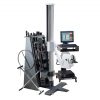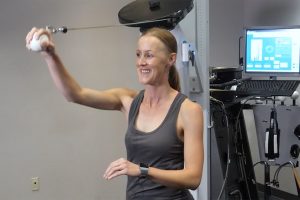
Rotator Cuff Evaluation: Standardized Tests, Strength, ROM, and Questionnaires
Treatment GuidelinesAn effective rotator cuff evaluation incorporates subjective patient observations and documents objective, measurable data. Let’s review some of the many parts of a rotator cuff evaluation, including the patient history, standardized assessments, a differential diagnosis, and tests for strength and range of motion.
An effective rotator cuff evaluation incorporates subjective patient observations and documents objective, measurable data. Shoulder pain is one of the most common complaints in outpatient treatment1. These injuries vary widely from moderate discomfort to a complete tear needing surgical repair. Therefore, a thorough evaluation will help determine how best to treat the patient and measure our progress.
Clinical data that is specific and reproducible provides the greatest accuracy in determining problems. It will also allow a clinician to measure progress throughout treatment. Including objective measurements in an evaluation increases our chances of reimbursement from third-party payers and gives our patients the greatest opportunity for success.
Let’s review some of the many parts of a rotator cuff evaluation, including the patient history, standardized assessments, a differential diagnosis, and tests for strength and range of motion.
Patient Report
A complete patient history provides vital information in planning treatment. Determining whether an injury is chronic or acute makes a significant difference in our approach. For a truly holistic perspective, we must review the impact of the injury on the patient’s activities of daily living.
Are they no longer able to work? Does their pain impact their performance in self-care tasks? Are they limited in their engagement in their hobbies? Identifying the patients’ goals early on is an important part of patient engagement. It helps them understand that your treatment can help them reach those goals, and increases their compliance, even when the exercises are difficult.
Other questions to consider include2:
- How much pain are they experiencing? And when?
- What aggravates or alleviates pain?
- Do they feel any clicking, locking, or grinding?
- Is the injury to their dominant hand?
- Are their home or work activities impacted?
- Is the patient experiencing paresthesia (numbness or tingling)?
- What other treatment methods have been tried?
Standardized Assessments for Rotator Cuff Evaluations
Standardized testing can supplement the information in a patient’s initial report. Questionnaire-based tests, such as the DASH (Disabilities of the Arm, Shoulder, and Hand) Outcome Measure, can help. As a quick measurement of difficulty in daily tasks, the DASH can be given periodically over treatment to determine progress. Other similar tests, such as the COPM (Canadian Occupational Performance Measure), can provide more detail on patient goals for therapy.
Differential Diagnosis
In some treatment settings, physicians have already made a definitive diagnosis. In other cases, a clinician should take a moment to rule out alternative sources of dysfunction. For example, tears of the surrounding tissues, such as the glenohumeral ligament, can mimic rotator cuff tears1. Cervical disc injury or deterioration can produce similar signs and symptoms2. And adhesive capsulitis, frozen shoulder, sprains, and osteoarthritis can all cause similar limitations1.
Patient reports, clinical observation, and diagnostic imaging can all work together to give a complete picture of the injury. Successful treatment begins with an accurate diagnosis.
Specific Rotator Cuff Tests
As the rotator cuff comprises four separate muscles, each with different functions, testing can reveal which muscles are affected and to what extent. Though it may not be practical to perform each one during evaluation, it is beneficial to be familiar with the tests.
After an initial examination and patient history, these tests may help direct the treatment plan. It would be difficult to provide an exhaustive list of all possible special tests. But a few of the most common and specific ones can be a good foundation for a practitioner.
Lift-off Test for Rotator Cuff Evaluations
The Lift-off Test can determine subscapularis involvement2. With the involved arm extended and internally rotated, a patient will place their hand on their lower back. A positive test finds the patient unable to lift the back of the hand off the lower back. Whether due to weakness or pain, this tests positive for subscapularis involvement.
Empty Can Test for Rotator Cuff Evaluations
You can evaluate supraspinatus with the Empty Can Test, also known as Jobe’s Test1. With the shoulders abducted to 90° and in forward flexion, the patient internally rotates to turn the thumbs downward. Then, with the hands as if pouring out an empty can, the patient elevates the arms against resistance. At this point, the clinician essentially performs manual muscle testing in this position. Weakness in this position, especially compared to when angled forward 30°, is a positive test for supraspinatus involvement.
External Rotation Lag Sign for Rotator Cuff Evaluations
The External Rotation Lag Sign assesses the infraspinatus1. While seated with their back facing you, passively flex the patient’s elbow to 90° with the shoulder elevated 20° in the scapular plane. After bringing the elbow to nearly end range of external rotation, the clinician asks the patient to maintain that position.
The test is negative if the patient can hold the position after the you remove your hands. Infraspinatus or possible supraspinatus involvement would find the patient demonstrating a “lag” or a “drop” in the arm.
Hornblower’s Sign Test for Rotator Cuff Evaluations
The Teres Minor can be tested by looking for Hornblower’s Sign1. The clinician will passively adduct the affected arm and flex the elbow to 90°. If the patient cannot externally rotate against resistance, this indicates Teres Minor involvement.
Range of Motion Evaluations for Rotator Cuff Injuries
With the knowledge of the affected muscles, range of motion measurements can provide more detailed information. For example, supraspinatus is primarily responsible for abduction, teres minor and infraspinatus provide external rotation, and subscapularis internally rotates. It is best to measure both active and passive ranges of motion; limitations in passive range can indicate problems in joint articulation.
A goniometer provides a detailed and accurate measurement that the clinician can recreate in the future. Then, improvements in later measurements clearly display progress. Measuring the range of the involved and the unaffected shoulder can also guide treatment and indicate progress later on.
One drawback of traditional goniometers – the handheld, plastic ones – is their lack of precision and the fact that they are prone to human error. A more precise and accurate way to measure range of motion is with a digital goniometer that measures movement in realtime and records the range. Advanced systems like those in BTE’s Evaluation Family produce scientifically superior measurements that strengthen your evaluations, treatment, and documentation.
Strength Testing for Rotator Cuff Injuries
Manual muscle testing (MMT) can provide valuable insight into muscle weakness and atrophy. This test can run from zero to five or with scores of Zero, Trace, Poor, Fair, Good, and Normal. By maintaining specific positions against gravity or added resistance, the patient demonstrates the strength of particular muscles. Patients unable to perform MMT due to range of motion considerations can be tested in anti-gravity positions to provide an accurate reading.
While MMT is a common practice in many clinics, the best way to truly document changes in strength over time is with dynamometry. Dynamometers measure strength with objective data, eliminating any subjectivity. Start with a baseline measurement of the afflicted shoulder, and repeat the measurement periodically throughout treatment to track progress.
The benefits of dynamometry go beyond the superior quality of measurement. Sophisticated dynamometers with advanced software will generate progress reports with graphs and tables for each patient and automatically track progress between sessions. This reporting helps show patients (and referrers and case managers) the value of your treatment, keeping them engaged and confident in their progress.
Rotator Cuff Evaluations with Simulator II
Most dynamometers measure only isometric contractions, but if you want to measure and report a full range of upper extremity activity, check out the Simulator II. The Simulator II is a complete system for objective evaluation and treatment, with included evaluation protocols for isometric and isotonic movement, maximum and repetitive lift, and consistency of effort testing. For your rotator cuff evaluations, the Simulator II objectively measures strength, ROM, and functional capacity, and generates detailed progress reports that you can share with clients.
Documentation of Rotator Cuff Evaluations
Despite the accuracy required, this evaluation process is not particularly time-consuming. The more experience gained with goniometry and strength testing, the more quickly you can determine the greatest needs of the patient. Documenting all measurements increases reimbursements and enhances your own records. Comparing the measurements taken at evaluation to those at discharge can encourage both the patient and the clinician.
Conclusion
Rotator cuff injuries are common in outpatient clinics. While improving your evaluation of this condition, you can apply the same principals with your other patients. Evaluating patient reports, differential diagnoses, ROM measurements, strength testing, and specialized tests will provide a thorough examination of the condition, enabling you to treat rotator cuff injuries safely and with confidence.
Sydney Moninger, COTA/L is an Occupational Therapy Assistant and freelance writer. She has more than 10 years of clinical experience working in pediatric, orthopedic, and geriatric settings. Most recently, she has been helping patients at a pain management center for orthopedic injuries. Sydney is passionate about patient education and increasing health literacy in the community, which is what got her started in her writing in the first place. She loves discovering new perspectives that improve her clinical practice, and connecting with others on LinkedIn or her Upwork page.
References:
- Woodward, T. 2000. “The Painful Shoulder: Part I. Clinical Evaluation”. AmFam Physician. https://www.aafp.org/afp/2000/0515/p3079.html
- Athwal, G. 2017. “Rotator Cuff Tears”. OrthoInfo. https://orthoinfo.aaos.org/en/diseases–conditions/rotator-cuff-tears/
- Jain, N. B. 2013. “Clinical Examination of the Rotator Cuff”. NCBI. https://www.ncbi.nlm.nih.gov/pmc/articles/PMC3826176/





